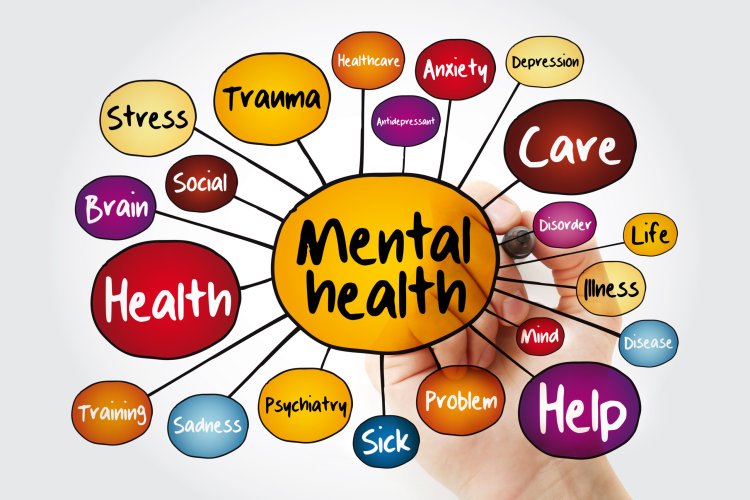What Is Mental health awareness ?
For the large Indian population to be involved in its own mental health, the only way forward is through enhancing mental health awareness

India shares the global community's deep concern about the state of mental health. When we look at how quickly the field of mental health is progressing, we see that it is moving painfully slowly. In 1954, Dr. Brock Chisholm, the WHO's first Director-General, made the prophetic statement, "without mental health, there can be no true physical health."[1] The situation has not changed significantly in almost 60 years. Neuropsychiatric illnesses account for about 14% of the worldwide disease burden. Due to a lack of understanding of the connections between mental illness and other health problems, the true extent of the problem has probably been understated.[2] The burden of health problems and resolving inequities in the causes and treatments of these diseases are still major challenges.
Most low- and middle-income countries have made only modest strides in improving access to mental health care. The lack of a mental health perspective in public health leadership, the difficulties in providing mental health care in primary-care settings, the small number of people with the necessary training, and the limited availability of funds are all obstacles.[3] Many efforts have been made to enhance results by calling on political will, increasing lobbying, and rallying community participation.
It is timely to investigate the paradigm of mental health awareness as a tool for reducing discrimination, improving prevention, making early diagnosis more likely, and igniting easy, effective community responses. Opportunities exist today thanks to the increasing recognition of mental disorders as key targets of global health action and the ability to use new technologies, such as the internet, big data, and mobile phones, to scale up effective, low-cost interventions in the field.
MENTAL HEALTH AWARENESS
The results of the mental health awareness programmes have been encouraging. Family involvement, treatment sensitization, and community integration are just a few of the methods used to raise awareness and combat stigma associated with mental health issues.[4,5] The mental health care delivery system has difficulties due to a lack of understanding of mental diseases.[6] Studies have shown the importance of community-based systems in developing nations, and the good results of raising awareness and its subsequent effect on citizens' propensity to get involved.[7]
There is a direct correlation between awareness and health literacy. Ignorance and false beliefs can lead to stigma and discrimination.[8] Few research have attempted to quantify Indians' mental health literacy levels. One study indicated that adolescent mental health literacy was extremely low, with just 29.04% of respondents able to correctly identify depression and 1.31 % able to correctly identify schizophrenia or psychosis. There was shown to be stigma associated with asking for aid.[9]
These results emphasise the significance of spreading information about mental health. Similar to physical health literacy, mental health literacy assesses how well informed a person is about mental health issues. What is meant by "health literacy"? It's the "ability to access, understand, and use the information to promote and maintain good health."[10] Recognising mental health issues; understanding their root causes; providing for one's own care; easing the path to professional involvement; and knowing how to utilise the internet effectively are all part of what is known as "mental health literacy" [Table 1]. Information that is already available in the public domain can be used to combat attitudes that impede recognition and appropriate help-seeking. The Norwegian initiative to shorten the average length of untreated psychosis is only one example of how raising public awareness can have a positive effect on mental health outcomes.
INDIAN SCENARIO
The World Health Organisation has identified the impact of mental illness and suicide on sustainable development goals. In 2015, India had a suicide rate of 15.7 per 100,000 people, which was higher than both the regional rate of 12.9% and the global rate of 10.6%.[14] In India, between the ages of 15 and 29, suicide is the greatest cause of death.[15] There is still a huge unmet need on the part of the general public.
The absolute disparity between the prevalence of mental diseases and the proportion treated is 76%-85% in less developed nations, making up the treatment gap.[16] Inadequate funding is often cited as a primary cause of the treatment gap. Both India's physical facilities and its human resources are inadequate.[17] India still has a major impact on the worldwide illness burden despite progress in many areas of health. When compared to other middle-income countries and India's neighbours, our health indices are poor. High out-of-pocket health care costs have a devastating effect on many people, driving them into poverty while also delivering subpar results.[18] Delivering effective treatments in low-resource areas has been deemed possible through the use of task-shifting to nonspecialist community health professionals.[19] Piggybacking on primary care systems and using new force-multipliers are future directions to take in light of the severe lack of psychiatrists, psychologists, psychiatric nurses, and social workers.
ROADMAP FOR MENTAL HEALTH AWARENESS
The only way to get India's massive population invested in its own mental health is to raise knowledge, which will spur demand. The adoption of preventative measures, early diagnosis, and easier access to treatment are all logical outcomes of increased public understanding. As knowledge grows, it is reasonable to anticipate increased advocacy, political will, funding, and synergies in a democratic society. It is expected that the following six channels will generate the most awareness-raising contributions:
Conventional media
The foundation of prior work in the field of mental health awareness has been the media. The most successful media campaigns have relied on a combination of high-profile advocates, such as actress Deepika Padukone, who recently spoke out about her own battle with depression, catchy advertising slogans, and informative documentaries.
The Indian Psychiatry Society, other research organisations, medical colleges, etc. all have websites where journalists and other content providers (such as internet portals) can easily access evidence-based mental health material. Making content that is easily translated and does not use jargon available in a number of regional languages will be very helpful. Professionals in the field of mental health should also set the example when it comes to working with the press. The dearth of genuine accounts can be remedied by encouraging cured patients to share their experiences with the world.

Government programs
There has been some criticism of the amount, but the government is still the largest funder of mental health services. Public health systems can only reach rural populations through large-scale programmes, yet most novel initiatives are limited to urban centres. The National Rural Health Mission, in addition to the National and District Mental Health Programmes, is rapidly evolving into the principal mode of transport for the provision of mental health as part of integrated primary care at the forefront of the public healthcare system. Given its collaborative nature with established private and alternative care providers, it stands to increase the efficacy of massive scale initiatives.
Educational system
Before the age of 24, while most people are still in school, the majority of people develop persistent and disabling mental diseases. The educational system provides numerous openings for promoting mental health awareness, such as the incorporation of narratives on mental health into curricula with the goals of de-stigmatization, elimination of discrimination, and early diagnosis, and the empowerment of stakeholders for early detection and straightforward interventions.
Industry

Mental illness causes a severe drain on productivity in the organised sector's labour force. Consistent efforts to raise awareness about mental health are necessary for businesses to keep their employees healthy and productive.
Internet, social media and cellphones
Portable electronics and online social networks have the potential to revolutionise the dissemination of successful mental health interventions by means of targeted amplification. Decisions will be better informed by the recognition of subtle and dispersed patterns across enormous volumes of data as their use grows.
Crowd-sourcing
When knowledge and technology fully combine in a free society, crowd-sourcing emerges as a powerful tool for overcoming geographical, historical, and economic limitations. It's the active participation of offline and online groups working together to effect positive change. As a result, the innovative ideas of individuals can be amplified across space and time by combining forces with the achievements of non-governmental organisations. When it comes to trying out unconventional ideas, crowd funding has shown to be a viable method.
CONCLUSION
The time has come to take on a new strategy with renewed vigour because the majority of the prior attempts to improve mental health over the past six decades or more in less-developed nations have failed. Raising awareness about mental health has the potential to be the catalyst for change. Government policies based on evidence-based approaches, an active media, a thriving educational system, a responsive industry, aggressive use of newer technology, and inventive crowd-sourcing might all work together to eliminate the stigma associated with mental health issues.













